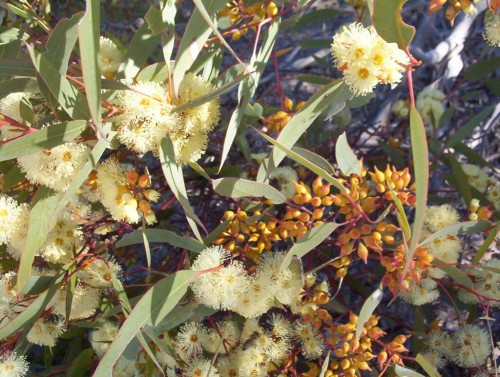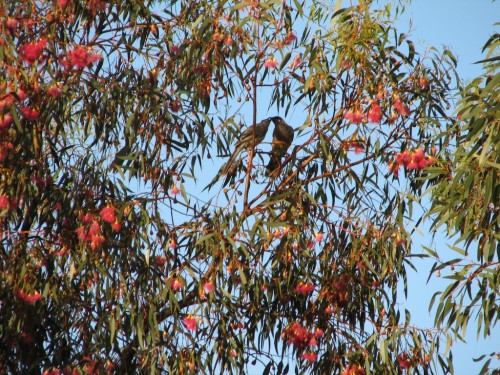Eucalyptus socialis (Red Mallee)
Most of the Eucalypts at Lowan Conservation Park are the mallee, Eucalyptus socialis. I found a good specimen to photograph. I wanted to gather an album of local Eucalypts.
The mallees are great survivors. When top branches are chopped down, or blown down, or burnt by bush fires, they shoot again from buds in the stump, called a lignotuber. The trees can look dead and be covered in new shoots within weeks.
Eucalyptus leucoxylon (South Australian Blue Gum)
This is one of those situations where one cannot use the common name for the species. Blue gum is the common name given to a few Eucalypts. The Tasmanian Blue Gum is Eucalyptus globulus. The Victorian Blue Gum is Eucalyptus globulus subspecies bicostata. The Sydney Blue Gum is Eucalyptus saligna.
This photo has Little Wattle Birds in the canopy of the tree. We were visiting a garden and sitting outside having a cuppa watching all this bird activity.
Australian Native Trees and Tall Shrubs For Dry Areas
This is the first list of plants for dry and alkaline soils. They need to be watered regularly for the first few months at least.
- Acacia pycnantha (Golden Wattle) Australia’s floral emblem. 4-8m high in ideal conditions.
- Acacia saligna (Golden Wreath Wattle) 3-8m high.
- Acacia baileyana (Cootamundra Wattle) to 6m. Amazingly, this does well here.
- Eucalyptus leucoxylon forms
- Eucalyptus diversifolia
- Eucalyptus porosa
- Eucalyptus stricklandii
- Eucalyptus spathulata
- Eucalyptus woodwardii
- Eucalyptus torquata (Coral Gum)
- Eucalyptus platypus
- Eucalyptus macrocarpa (Rose of the West or Mottlecah)
- Eucalyptus ficifolia (Western Australian Flowering Gum)
- Eucalyptus erythrocorys (Red Cap Gum)
- Eucalyptus eremophila
- Eucalyptus forrestiana (Fuschia Gum)
- Eucalyptus pyriformis (Pear Gum)
- Eucalyptus sideroxylon (Iron Bark)
- Grevillea robusta
- Santalum acuminatum (Wild Peach, Quandong)
This is not an exhaustive list. If you know of more species to add to this list (ie. dryland planting plus alkaline soil), let me know, please.
Kurrajong–Brachychiton populneus
This is the tree that I wrote about in the previous entry on the blog.
According to the Encyclopaedia of Australian Plants (Elliot and Jones), the Kurrajong is a widespread tree often found in rocky areas but also extending along river banks and plains in a variety of soils. The tree makes an excellent shelter belt and shade tree for home gardens, parks and street planting.
The foliage is liked by stock. Young leaves are tinged with pink. The trunk has grey bark, although it is green when young. Flowers are 1-2 cm long, bell-shaped pink or cream with red flecks and blotches inside the bloom.
The roots of the tree were eaten by Aborigines. The fibres of the trunk were used for making fish nets and twine. Seedlings make excellent indoor pot plants.
Kurrajong are easy to grow although they may be slow whilst young, hence their success as potted plants. They respond well to slow release fertilisers and are drought tolerant. They do appreciate water during dry periods. They are frost hardy. The trees drop their leaves just before flowering. They can be transplanted readily.
This species is grown in the southern states of the USA.
Coffee from Kurrajong
I have been looking through an old (2004) Journal of the Society for Growing Australian Plants (Queensland Region). There is an interesting article on using the seeds of the Kurrajong (Brachychiton populneus) as a coffee substitute. The early settlers in the region first used it as such, including the explorer Ludwig Leichhardt. The seeds need to be husked, and then roasted like coffee beans, before being ground and brewed.
The tree is grown quite widely in Australia, including many areas of Southern Australia. The foliage has often been used as fodder for farm animals. They are often planted as ornamental trees in public parks. In summer the trees have clusters of creamy grey flowers which have red splotches all over the cream interior of the bell shaped flowers. The seeds are found in green seed pods, which gradually turn brown and then split open with yellow seeds.
Now is a good time to be looking for the seed pods. It is best to pick the lot once about a third of the pods have become brown. The problem comes at this stage because the birds love the seeds. Cockatoos, rosellas and choughs are partial to the seeds. Store the green pods out of reach of the birds for a few days while they ripen.
From the information in the article, it would be worth growing the tree to use the seeds, if you can win the battle with the birds.
The seeds have fine hairs which irritate greatly, so take care. Use a knife to split the pods and use a pair of leather gloves to rub the hairs off the seeds. Blow the hairs from the seeds and dry the seeds for a few days before storing them. (Watch out for the birds.)
Use a frying pan with a lid to roast the seeds on high heat, or if using an ordinary stove top pan stir all the while. This is how coffee is treated. The roasting is done according to the strength of the flavour you prefer. According to the article the flavour of the brewed ‘coffee’ is something like Mocha or long black Espresso coffee. The roasting is carried out until the Kurrajong seeds are the colour that you like in coffee.
Once roasted, the seeds are stored in a glass jar until needed for grinding. The suggested amount to use is a heaped dessertspoon of ground Kurrajong seeds per cup. Put the ‘coffee’ in a saucepan, cover with boiling water and bring back to the boil. Let stand a few minutes before straining and serving.
I don’t like coffee at all. I would rather try different teas. However I would be very interested to find out how this truly tasted.

